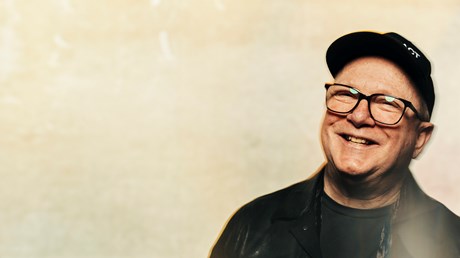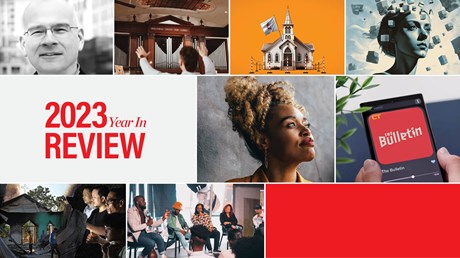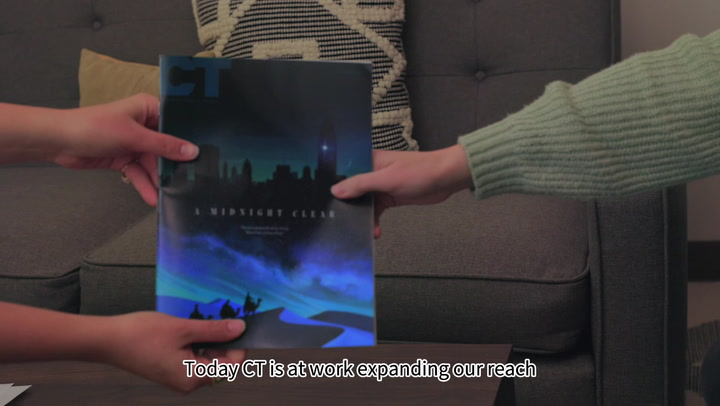Will you help encourage and connect the church?
Give NowWill you help encourage and connect the church?
Give NowNotice anything different? The look of Christianity Today magazine has come a long way since its first issue in 1956. In the beginning, Christianity Today had minimal, if any, images. "When there were pictures, they were only there as they would appear, say, in a dictionary, just to support the content," says design director Gary Gnidovic. Slowly at first, the magazine started to look less like a scholarly journal and more like a consumer magazine. The type and wording on the cover became less formal—although it is fun to see "fortnightly publication" on the early covers—and color and illustrations began appearing on the covers in the 1960s. The changes seemed to follow a natural progression, keeping some of the same look while moving on to a fresh appearance.
The latest redesign of Christianity Today magazine is the most radical in its history. As Gnidovic points out, CT hasn't had many redesigns, although they come at a faster pace now: Since 2000, he's overseen three, the last one in 2009. "As time moves on, we redesign more quickly, more frequently, because the nature of the culture is moving so much faster."
In the publishing industry, redesigns are common, even necessary, in order to keep up with both consumers and competing magazines. These new looks also appeal to a "visually savvy audience," as Gnidovic says. A younger generation is accustomed to certain visual elements, and is therefore attracted to those things.
Executive editor Andy Crouch, who initiated the project, also saw the redesign as a way to signal the change in CT leadership. Towards the end of 2012, Terumi Echols, Mark Galli, Katelyn Beaty, and Crouch stepped into new roles at CT. With the new leadership, Crouch says, "I think the most important thing was to signal we are trying some new things. We want a more engaged relationship with our readers and we want to show how actively we are in dialogue with and in conversation with the wider culture."
CT decided to hire an outside design firm to create the new look. Metaleap Creative was chosen because it's outside of the Christianity Today culture and could offer a new perspective.
CT gave Metaleap quite a bit of freedom in creating the new design. Its main instructions? "Don't do something minor. We want a dramatic change," says Crouch. He refers to when people first saw president Harold Smith's redecorated office: "We want our readers to have that experience: 'Oh, this is really different. I don't know if I would've made these choices, but I kind of like it, and someone really thought about it.'" Sometimes, Christian or church periodicals tend to stick to safe or nice design choices. CT, however, has made bold design decisions to keep pace with the publishing industry as a whole, both with the latest redesign and past issues.
One of the first and most important decisions of a redesign is the font. Gnidovic says they thought of keeping the font from the previous design, but found one that "perfectly conveys the spirit of CT." Periódico Text, designed by Eduardo Manso in 2011, has a classic look to it. "It is a font that is clearly rooted in the past, has respect for the past, for the classical typefaces going back hundreds of years, but it also presents a very fresh and futuristic interpretation," explains Gnidovic. "And that's what Christianity Today is all about: there's a great respect, admiration, and a great deal you can learn from the past, but we're also about today and moving into the future."
Recreating the cover, too, was a vital task. Crouch focused on having a cover that people would want to be seen reading. In order to give the designers more room to create such compelling covers, "Christianity Today" was condensed to "CT" in the upper left hand corner. The decision was a long time in the making. Changing to "CT" had been under consideration during the 2009 redesign, but people were unsure if readers would be ready to accept it. Some readers have expressed their displeasure since the new look appeared, but there have not been many complaints.
With change of any kind, negative feedback is to be expected. And the editors and designers take the criticism to heart and make adjustments as necessary, such as the font size or weight for increased legibility. But the great majority of response from readers has been positive, and Metaleap and CT—which together spent several hundred hours on the redesign—can enjoy its work. "We're having a little bit more fun with the magazine," says Gnidovic, considering how images work with the text today as opposed to the first issues. "But there's every bit the substance there always was. It's just coming off a little different now."
Elissa Cooper is assistant editor of Christianity Today magazine.








